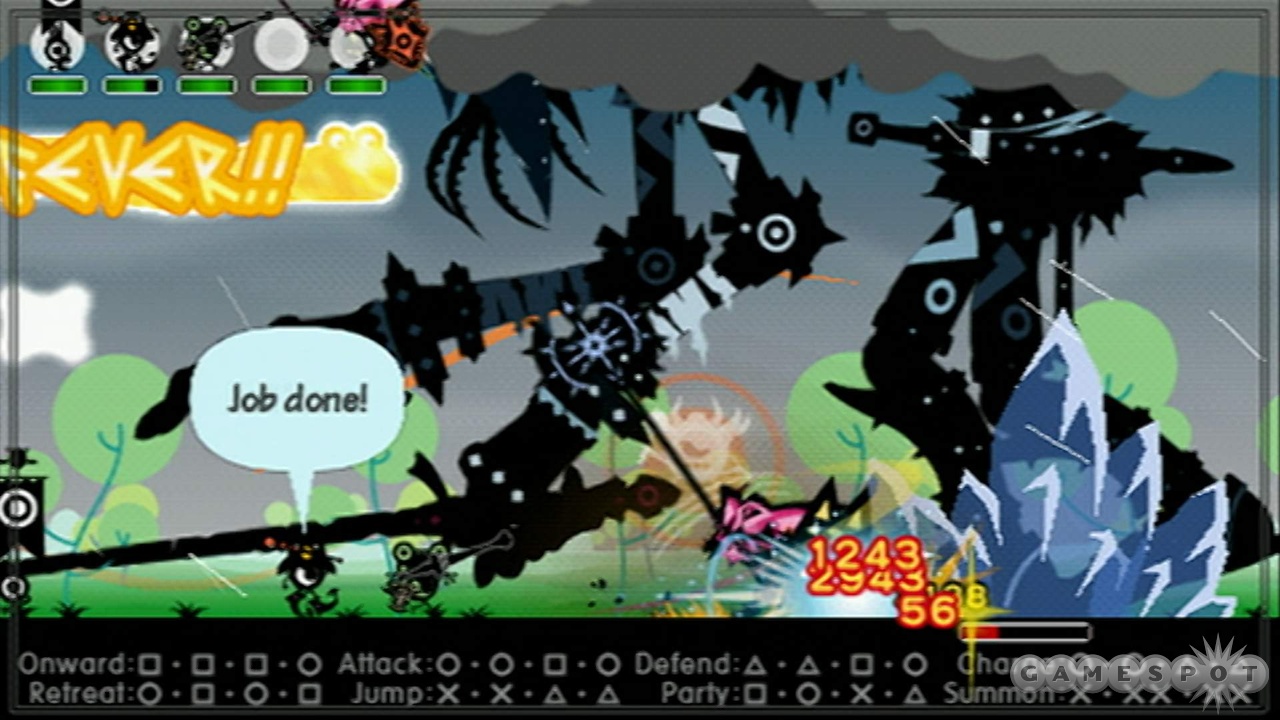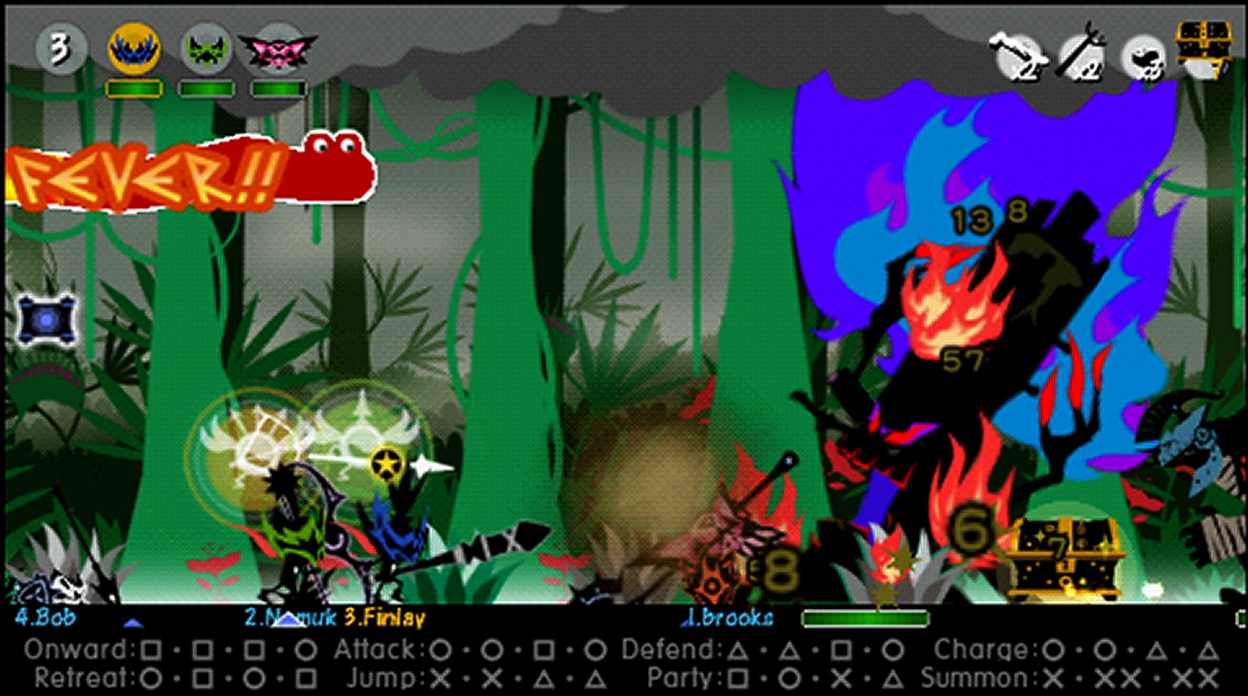If you're familiar with previous Patapon games, it might come as some surprise to you that in Patapon 3 you don't get to command an army. You're still a deity worshipped by the titular tribe, and you still get to issue the little guys orders by rhythmically tapping on sacred drums mapped to the PSP's face buttons, but the army has been turned to stone, so you have far fewer units at your disposal. All is not lost, though; not only have you been summoned into the body of a reincarnated hero, but there's so much emphasis on loot and leveling this time around that your small band grows more powerful practically every time you play. They can get so powerful, in fact, that where previous games have generally required careful strategizing to succeed, here it's often possible to forgo defensive and evasive moves in favor of an all-out offense. Still, there's plenty of challenge to be found in the colorful combat zones of Patapon 3, and even as you're decimated by a dragon or digested by a demon it's hard not to be won over by the game's quirky presentation and succumb to its just-one-more-try gameplay.
After picking one of three Patapon heroes to play as (would you prefer a bow, a spear, or a sword and shield combo?), four training missions do a good job of familiarizing you with most of the commands in your repertoire. There are only seven initially, including "onward," "attack," "defend," and the like. Each command is issued by hitting a different sequence of four drum beats in time with the music; you press circle, circle, square, circle to attack, for example. Those four beats compose one musical measure, and after you enter them it takes another measure for the Patapons to carry out your order. It's an unusual and satisfying way to command your forces as they march across the screen, and it's made less intimidating for newcomers by both a list of the correct inputs at the bottom of the screen and a flashing border that makes it easier to keep in time. String together a number of well-timed orders, and your units go into a fever that makes them significantly more powerful. Hit an unrecognized sequence of drums or miss the beat completely, and your troops just stand around looking confused. Patapon 3 is less punishing than its predecessors where the timing of your drum beats is concerned, but it also rewards you for perfectly timed beats by having them trigger your hero units' powerful special moves.
Although your chosen hero is accompanied on all missions by three other combat units, heroes are so powerful that it often feels like the other guys are just marching in the wake of your one-man army. This is certainly true early in your adventure, but as you unlock additional unit types and they gain access to more abilities and equipment, you definitely can't afford to ignore them. There are 21 unit types in Patapon 3, plus hero variants of all of them, and while it's possible to stick with the same team for extended periods of time, you inevitably encounter challenges that require a different approach. You might choose to replace a healer with an archer for a mission in which you're not taking a lot of damage, or replace all of your ranged units because their projectiles are falling short in an oncoming wind, for example. It's fun to experiment with different formations, and because leveling up units that you don't use regularly unlocks abilities that are shared with those you do (you can even change the direction of that wind), you handicap yourself if you stubbornly stick with your favorites. Unfortunately, leveling up units that you don't use regularly can be a chore if you leave it until late in the game to try to catch them up. Yes, you can give them high-level equipment, group them with your most powerful hero, and run them through missions that would normally be beyond them, but they still don't gain levels quickly.

The occasional need to grind unit levels is at least acknowledged; missions that incorporate story events can't be replayed once you've beaten them, but typically upon beating said missions, you unlock one or two more in the same locale that can be replayed as much as you like. These missions even have descriptions that let you know whether they're particularly well suited for leveling or for collecting currency and crafting materials for use at the gear-upgrading blacksmith. Playing through most levels you also collect treasure chests that are dropped or even thrown at you by large enemies. You get to open treasure chests only upon completion of a level, but their coloring and a numeric value at least give you some indication of how good your loot is going to be when you pick them up. That's good to know when you're fighting your way through one of the new three- or five-floor dungeons, because at the end of each floor you have the option to either retreat to your hideout with your loot and start the dungeon over or proceed and risk losing it. Any loot that you don't think is worth keeping can be dismantled at your armory to gain more crafting materials and currency, though you shouldn't rush to get rid of any weapons and armor just because they're not immediately useful. Weaker items in your inventory might occasionally be needed for specific levels because they offer a resistance to or are highly likely to cause effects like burn, sleep, freeze, and poison.
It would be an exaggeration to say that you end up spending as much time gearing up for missions as you do playing them, but at times it feels pretty close. You can automatically optimize all of your units by putting them in the best gear available at the push of a button, but this option doesn't take your next mission into account and so isn't always as useful as it could be. So, if you've just completed a mission that pitted you against fire-breathing dragon puppies and you're headed into one where the weather alone is enough to freeze ill-prepared Patapons, you really have little choice but to manually swap out your ice armor for flame armor. In addition to weather conditions and potentially fatal status effects, it behooves you to consider your offensive options. Weapons that are effective against demons and dragons aren't necessarily the same weapons that are good for bringing down golems and enemy towers. Patapon 3 throws an interesting assortment of enemies your way, many of which are recognizable from previous games, albeit with new attack patterns. Bosses and their larger minions pose some varied challenges, and though most of them clearly broadcast their lethal intentions a measure or two ahead of time, they become less predictable as their health bars shrink.
Additional variety comes courtesy of versus missions that, once encountered in your adventure, can be played online competitively. Not all of these are great, but the race and tower defense game types are a lot of fun. In obstacle races, two opposing forces of up to four player heroes start alongside each other and must race from left to right to the finish line while contending with all manner of enemies and obstructions. Obstacles that are colored either red or blue can be destroyed only by the team of the opposite color, while other obstructions and enemies are there for whoever wants them. This not only ensures that it's difficult for one team to pull massively ahead of another, but also introduces some strategy to the proceedings because it can be preferable to hang back and let your opponent deal with a particularly tough enemy. In tower defense battles, enemies start at opposite ends of the map and march toward the middle where, after capturing a number of cannon emplacements en route, they fight for control of the one in the middle and ultimately try to reach each other's base. Like the races, tower defense games work well because pushing forward as quickly as possible isn't always the best option; when you move into enemy territory, you leave your own cannons behind and might fall foul of your enemies' even though you're winning where territory is concerned.
Where Patapon 2 offered just one ad hoc multiplayer mode, Patapon 3 boasts an impressive suite of multiplayer options that are playable both locally and online. In addition to the aforementioned versus battles, you can play through almost any mission cooperatively, enter special multiplayer dungeons that you're locked out of when playing solo, and team up to take down rare and powerful world bosses who show up randomly between missions as you progress. (You don't need teammates to take down the world bosses, but they can make the battles a lot easier.) Furthermore, you can visit the hideouts of other players and make use of their vendors and blacksmiths, who might offer and specialize in items different from your own. There's also a clan system in place, though that's something of a misnomer given that forming your own clan is mandatory before you can play online. It's really just a fancy friends list with a system in place for rewarding you when you interact and team up with other clan members. Regardless, it serves its purpose and can make finding people to play with much easier if the regular options to search by game types and hero levels relative to your own aren't yielding any results.

Whether you're playing solo or with friends, Patapon 3 delights at every opportunity. The upbeat soundtrack offers plenty of variations on the same theme for you to keep time with; the stylized characters are wonderfully animated; and rare weapons are so gloriously over-the-top that they make those favored by Final Fantasy protagonists look like toothpicks. You have ample opportunity to enjoy all of these neat touches as well, despite the fact that maintaining your rhythm and always thinking one or two measures ahead requires a high level of concentration. Incidentally, and incredibly, Patapon 3 is the first game in the series to offer a "pause" option, though it's not available from the outset. Before you can pause the game using a special drum sequence (so as not to break your rhythm when you come back to the game), you first need to retrieve an item from the very first training mission. You could be forgiven for thinking that this isn't a problem, but you need to string together a near-perfect sequence of "advance" and "attack" orders to reach said item, and even returning to the mission once you've leveled up your group doesn't make it a cakewalk. The ability to pause your game mid-mission is a welcome addition, but it's one that you shouldn't have to work nearly so hard for.
Patapon 3 is a great game that, depending on your play style and whether or not you're enlisting the help of other heroes, could easily take you 40 or more hours to complete. And once you're finished, there's a good chance that you'll want to keep on playing in order to level up the rest of your Patapons (42 total) and get them geared up in preparation for multiplayer sessions. You might lament the heightened focus on gear, leveling, and squad selection if you're a fan of previous games, but that shouldn't deter you from spending $20 on a game that delivers dozens of hours of great gameplay.